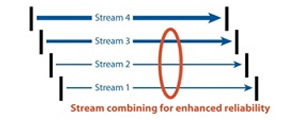Superior Data Rates, Range and Reliability
Systems with multiple antennas at the transmitter and receiver – also referred to as Multiple Input Multiple Output (MIMO) systems – offer superior data rates, range and reliability without requiring additional bandwidth or transmit power. By using several antennas at both the transmitter and receiver, MIMO systems create multiple independent channels for sending multiple data streams.

4x4 MIMO system supports up to four independent data streams. These streams can be combined through dynamic digital beamforming and MIMO receiver processing (in the red oval) to increase reliability and range.
The number of independent channels and associated data streams that can be supported over a MIMO channel is equivalent to the minimum number of antennas at the transmitter or receiver. Thus, a 2x2 system can support at most two streams, a 3x3 system can support three streams and a 4x4 system can support four streams, as illustrated in The figure below. Some of the independent streams can be combined through dynamic digital beamforming and MIMO receiver processing, as shown in the red oval, which results in increased reliability and range.
A 4x4 MIMO system with dynamic digital beamforming and MIMO receiver processing supports two maximum-rate data streams, 99 percent of the time. Other configurations such as 2x2 and 3x3 MIMO are significantly less reliable, since they have fewer antennas and thus fewer extra spatial dimensions that can be combined.
